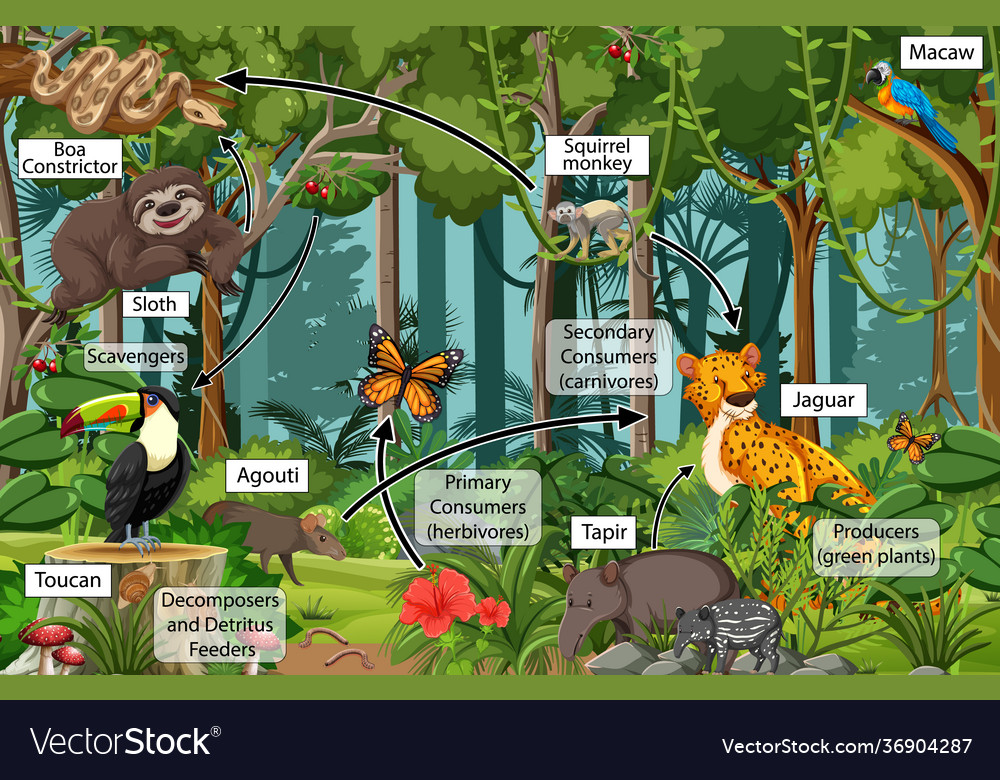Rainforests are home to an incredibly diverse range of wildlife, with a multitude of species interacting through a complex web of food chains and relationships. This intricate network of feeding interactions is known as a food web and plays a crucial role in maintaining the delicate balance of the rainforest ecosystem. We will describe about Food Web Rainforest Animals. Lets see…
The Layers of the Rainforest
Before delving into the fascinating food web dynamics of rainforest animals, it’s essential to understand the structure of the rainforest itself. Rainforests are typically divided into four layers:
| Layer | Description |
|---|---|
| Emergent Layer | The uppermost layer where the tallest trees emerge above the canopy, often reaching heights of 200 feet or more. |
| Canopy Layer | Comprising the majority of the forest’s greenery, this layer is home to a plethora of plant life and provides shelter for numerous animal species. |
| Understory Layer | Located beneath the canopy, this layer consists of smaller trees, shrubs, and young plants, creating a dense and intricate environment. |
| Forest Floor | The lowest layer where minimal sunlight penetrates, resulting in a layer of decomposing plant matter and a haven for various insects, amphibians, and reptiles. |
The Protagonists: Keystone Species
Within the rainforest ecosystem, certain species play a disproportionately large role in maintaining the structure and function of the community. These species, known as keystone species, have a significant impact on the diversity, abundance, and behavior of other organisms within the ecosystem.
One classic example of a keystone species in the rainforest is the jaguar. As a top predator, the jaguar helps regulate the population of prey species, preventing overgrazing and allowing for a more diverse range of plant life to thrive. Additionally, jaguars act as a natural control on smaller predator populations, which in turn impacts the populations of their prey.
The Interconnected Web: Understanding the Rainforest Food Web
The rainforest food web is a complex network of interconnected food chains, illustrating the flow of energy through the various trophic levels of the ecosystem. At the base of the food web are primary producers, such as plants and algae, which harness energy from the sun through photosynthesis.
Primary consumers, including herbivorous insects, birds, and mammals, feed on these producers, which are then consumed by secondary consumers—predatory insects, reptiles, and birds. Tertiary consumers, such as large carnivorous mammals and birds of prey, occupy the upper levels of the food web.
Examples Of Rainforest Food Chains
Let’s explore a couple of food chains within the rainforest to better understand the flow of energy and resources: These are…
1. Plant – Herbivore – Carnivore – Top Predator
- Plants: In the rainforest, a variety of plant species such as trees, fruits, and foliage serve as primary producers.
- Herbivores: Animals like sloths, howler monkeys, and insects feed on these plants for sustenance.
- Carnivores: Species like snakes, birds, and small mammals hunt and consume the herbivores.
- Top Predators: The apex predators, including jaguars, eagles, and large snakes, control the population of lower trophic levels.
2. Algae – Zooplankton – Small Fish – Large Fish
- Algae: Aquatic plants and algae in rivers and streams form the foundation of this aquatic food chain.
- Zooplankton: Tiny organisms such as small crustaceans and insect larvae feed on the algae.
- Small Fish: Species like tetras and guppies consume the zooplankton for their energy needs.
- Large Fish: Predatory fish such as piranhas and electric eels prey on the smaller fish, completing the chain.

Credit: www.vecteezy.com

Leave a Reply